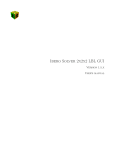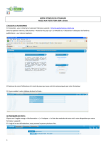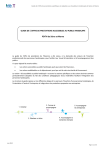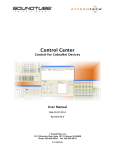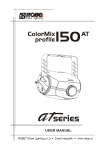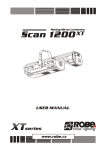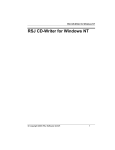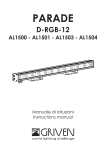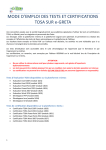Download Ibero Solver 2x2x2 LBL
Transcript
Ibero Solver 2x2x2 LBL Version 1.x.x User's manual Copyright (C) 2013 Ibero Rubik. Permission is granted to copy, distribute and/or modify this document under the terms of the GNU Free Documentation License, Version 1.3 or any later version published by the Free Software Foundation; with no Invariant Sections, no Front-Cover Texts, and no Back-Cover Texts. A copy of the license is included in the section entitled "GNU Free Documentation License". 2 Contents 1 2 3 Introduction 4 Downloading and installing 4 2.1 For Windows . . . . . . . . . . . . . . . . . . . . . . . . . . . . . . . . . . . . . . . . . . . . . . . . . 4 2.2 For Linux . . . . . . . . . . . . . . . . . . . . . . . . . . . . . . . . . . . . . . . . . . . . . . . . . . . 5 Use 6 3.1 In Windows . . . . . . . . . . . . . . . . . . . . . . . . . . . . . . . . . . . . . . . . . . . . . . . . . . 6 3.2 In Linux . . . . . . . . . . . . . . . . . . . . . . . . . . . . . . . . . . . . . . . . . . . . . . . . . . . . 7 4 Information shown by the program 8 5 License 8 6 FAQs 9 7 Links 10 8 GNU Free Documentation License 11 3 1 Introduction Ibero Solver 2x2x2 LBL shows the movements necessary to solve a 2x2x2 cube. The user enters the information of the colours of the cube (unsolved), and the program creates a list in a TXT le with the movements to solve it. The algorithms used in the program are those of the LBL (Layer-By-Layer) method; the upper part is solved rst, and then the lower part. 2 2.1 Downloading and installing For Windows The program is written in Fortran; that means before using it a compiler must be installed rst. This compiler lets the computer understand the applications written in this programming language. Here the compiler used is gfortran, which is part of the GCC (GNU Compiler Collection), created by the GNU Project. In the GCC Wiki (http://gcc.gnu.org/wiki/GFortranBinaries) there are several versions for Windows; the most user-friendly one is a typical installer: http://users.humboldt.edu/nneyb/gfortran-windows-20130301.exe After downloading it, run the le. A window like this will be shown: Figure 1: Window of the gfortran installer Install it. To install Ibero Solver 2x2x2 LBL, download from www.iberorubik.com the compressed le of the console version in English. Once downloaded, unpack it in a folder easy to nd (Desktop, for instance), because you will have to open it to write the colours of the faces (Figure 2). 4 Figure 2: Unzip the les in an accesible directory. CAUTION: The main folder can be renamed, but its content (the three folders and the binary le) must stay in the same folder. If one of these folders or the EXE le is deleted or moved, the program will not work. 2.2 For Linux In Linux, GCC compiler is usually installed. To check it, open the Terminal and write gfortran (without quotes). If the console writes back gfortran: order not found or something similar, you need to install it. To do that, follow these steps: 1. Write (without quotes) apt-cache search gfortran and press ENTER. 2. Among the results, search those with the structure gfortran-x.x - GNU Fortran compiler, where x.x will be the most recent version (Figure 3). 3. After that, type sudo apt-get install plus the most recent version, press ENTER and type your password. 4. When nished, check again if gfortran is installed. If so, close the Terminal. 5 Figure 3: Results shown by the Terminal. 3 Use 3.1 In Windows 1. To use the program in Windows, go to folder faces, and write the colours in every TXT le. The name of the faces follows the English notation: U → Up F → Front R → Right B → Back L → Left D → Down In the les, the colurs are written as a matrix. 2. To write what you see in the cube, take it with a face parallel to you, deciding which is the front face, the left face, the down face... Once decided, type the colours as shown in Figure 4: 6 Figure 4: How to write the colours. 3. After that, run the le Ibero Solver 2x2x2 LBL.exe, located in the main folder. 4. In a fraction of a second, the program solves the cube, and shows data describing the whole proccess: situation of the cube after applying each step, time... To exit the program, press any key and ENTER. 5. Go to folder results; there you will nd four TXT les: movements.txt: It contains all the movements to solve the cube. movements_step_0.txt: Contains (if necessary) a single movement to place the most solved face on the top. movements_step_1.txt: Contains the movements to solve the upper layer. movements_step_2.txt: It includes the 180º of the whole cube to place the unsolved part on the top, and the movements to place the yellow stickers in the U face. movements_step_3.txt: These algorithms permutates the pieces of the U face, and solves the cube completely. If in some step no movements were necessary, the associated le will be empty. 3.2 In Linux 1. Same as In Windows 2. Same as In Windows 3. In Linux, the program must be run through the Terminal, but rst it must be marked as an executable le. Right-click on run, go to Properties, and click on is executable. Then, open the Terminal in the main folder of the program and write (without quotes): ./Ibero_Solver_2x2x2_LBL 4. Same as In Windows 5. Same as In Windows 7 4 Information shown by the program First of all, the program shows the situation of the cube at the end of the dierent steps: Before resolution (that means, data of the faces les). After the pattern detection: The non-standard colours are rewritten so that the subroutines can work: black → white; purple → orange. After turning the cube and detecting the step: The most solved part of the cube is placed on the top to start with it. After the internal colour change: Since the subroutines are designed to start with white and nish with yellow, and the previous turn can make another colour be placed on the top, the program changes each and every colour internally, to turn the upper colour into white, the lower colour into yellow, etc. From this moment, what the program shows is not the real conguration of the cube, but the colours it uses. After putting the white stickers on the top and before permutation: Every white stickers is up, and half the rst step is done. After solving the rst step: The upper half of the cube is solved. After solving the second step: The yellow face is now U and it has been completed. After solving the third step: The cube is solved. Secondly, the program shows the movements saved by using the subroutine movement_reducer: For example, if the program writes U and U', these two movements are eliminated, because the nal state of the cube is the same (redundant movements are only deleted in movements.txt). 5 And nally it shows the approximate time the program takes to solve the cube. License This program is free software, licensed under the GNU General Public License (GPL) so, to sum up, the user can: 1. Run the program with no limitations 2. Distribute literal copies of the source code as they received it (in their web, by e-mail, pen-drives, CDs...) 3. Charge for this distribution what they want (or not) 4. Modify the program 5. Distribute modied versions by themselves as binary les, although including the source code. For paragraphs 2 and 5, in every source code le, they have to: Indicate the copyright Point out that the code is licensed under GPL Say that the program does not have any warranty Give a copy of GPL with the program This program can not be used as a part of a propietary (non free software) program. What explained here is just a summary, so if you want to use this program in your own project or modify this one, the result must be GPL too. That is why we encourage you to read carefully the conditions of this license. http://www.gnu.org/licenses/licenses.html. 8 6 FAQs Why Fortran, and not another programming language? Fortran is still using a lot in engineering. Also, it is a very eective language to handle matrices, and quite fast (runtime of this program is below 50 ms). However, we are using other languages too, such as Visual Basic for GUIs. Why do I need to install a compiler in order to run the program? This happens specially in Windows. Although Fortran is very eective in its eld, is not massively used, so Windows does not understand it by default. So the compiler allows to create the binaries in Windows from the source code, and to run them. I use Linux, and I cannot run the program; Terminal says Permission denied. Although the binary le has been marked as executable, it may not work. That might happen because of permissions of the hard disk drive where the program is (for example, external drives); by saving the main folder and its content in the internal disk drive, this issue should dissapear. What is all this information the program shows? All the information given by the program is explained in section 4 of this Manual. I have accidentally deleted one of the folders of the program. The program will crash when executed. We recommend you to download again the program from www.iberorubik.com. I have accidentally deleted a le. If it is a le from results folder or program_les folder, do not worry; they will be created again when the program is run. If it is from faces folder, the program will not work. You can create it manually, call it the same way as the rest of the les of that folder, and write the colours in it. How can I use this program according to its license? Since it is free software, you can copy, redistribute, modify and even sell it, but in all these steps the program must continue to be as free software (which means the user who receives it must have the same rights). Read section 5 of this manual or look for more information on the Free Software Foundation website. 9 7 Links www.iberorubik.com http://gcc.gnu.org/wiki/GFortranBinaries http://users.humboldt.edu/nneyb/gfortran-windows-20130301.exe http://www.gnu.org/licenses/licenses.html http://www.fsf.org 10 8 GNU Free Documentation License GNU Free Documentation License Version 1.3, 3 November 2008 Copyright (C) 2000, 2001, 2002, 2007, 2008 Free Software Foundation, Inc. <http://fsf.org/> Everyone is permitted to copy and distribute verbatim copies of this license document, but changing it is not allowed. 0. PREAMBLE The purpose of this License is to make a manual, textbook, or other functional and useful document "free" in the sense of freedom: to assure everyone the eective freedom to copy and redistribute it, with or without modifying it, either commercially or noncommercially. Secondarily, this License preserves for the author and publisher a way to get credit for their work, while not being considered responsible for modications made by others. This License is a kind of "copyleft", which means that derivative works of the document must themselves be free in the same sense. It complements the GNU General Public License, which is a copyleft license designed for free software. We have designed this License in order to use it for manuals for free software, because free software needs free documentation: a free program should come with manuals providing the same freedoms that the software does. But this License is not limited to software manuals; it can be used for any textual work, regardless of subject matter or whether it is published as a printed book. We recommend this License principally for works whose purpose is instruction or reference. 1. APPLICABILITY AND DEFINITIONS This License applies to any manual or other work, in any medium, that contains a notice placed by the copyright holder saying it can be distributed under the terms of this License. Such a notice grants a world-wide, royalty-free license, unlimited in duration, to use that work under the conditions stated herein. The "Document", below, refers to any such manual or work. Any member of the public is a licensee, and is addressed as "you". You accept the license if you copy, modify or distribute the work in a way requiring permission under copyright law. A "Modied Version" of the Document means any work containing the Document or a portion of it, either copied verbatim, or with modications and/or translated into another language. A "Secondary Section" is a named appendix or a front-matter section of the Document that deals exclusively with the relationship of the publishers or authors of the Document to the Document's overall subject (or to related matters) and contains nothing that could fall directly within that overall subject. (Thus, if the Document is in part a textbook of mathematics, a Secondary Section may not explain any mathematics.) The relationship could be a matter of historical connection with the subject or with related matters, or of legal, commercial, philosophical, ethical or political position regarding them. The "Invariant Sections" are certain Secondary Sections whose titles are designated, as being those of Invariant Sections, in the notice that says that the Document is released under this License. If a section does not t the above denition of Secondary then it is not allowed to be designated as Invariant. The Document may contain zero Invariant Sections. If the Document does not identify any Invariant Sections then there are none. The "Cover Texts" are certain short passages of text that are listed, as Front-Cover Texts or Back-Cover Texts, in the notice that says that the Document is released under this License. A Front-Cover Text may be at most 5 words, and a Back-Cover Text may be at most 25 words. A "Transparent" copy of the Document means a machine-readable copy, represented in a format whose specication is available to the general public, that is suitable for revising the document straightforwardly with generic text editors or (for images composed of pixels) generic paint programs or (for drawings) some widely available drawing editor, and that is suitable for input to text formatters or for automatic translation to a variety of formats suitable for input to text formatters. A copy made in an otherwise Transparent le format whose markup, or absence of markup, has been arranged to thwart or discourage subsequent modication by readers is not Transparent. An image format is not Transparent if used for any substantial amount of text. A copy that is not "Transparent" is called "Opaque". Examples of suitable formats for Transparent copies include plain ASCII without markup, Texinfo input format, LATEX input format, SGML or XML using a publicly available DTD, and standardconforming simple HTML, PostScript or PDF designed for human modication. Examples of transparent image formats include PNG, XCF and JPG. Opaque formats include proprietary formats that can be read and edited only by proprietary word processors, SGML or XML for which the DTD and/or processing tools are not generally available, and the machine-generated HTML, PostScript or PDF produced by some word processors for output purposes only. 11 The "Title Page" means, for a printed book, the title page itself, plus such following pages as are needed to hold, legibly, the material this License requires to appear in the title page. For works in formats which do not have any title page as such, "Title Page" means the text near the most prominent appearance of the work's title, preceding the beginning of the body of the text. The "publisher" means any person or entity that distributes copies of the Document to the public. A section "Entitled XYZ" means a named subunit of the Document whose title either is precisely XYZ or contains XYZ in parentheses following text that translates XYZ in another language. (Here XYZ stands for a specic section name mentioned below, such as "Acknowledgements", "Dedications", "Endorsements", or "History".) To "Preserve the Title" of such a section when you modify the Document means that it remains a section "Entitled XYZ" according to this denition. The Document may include Warranty Disclaimers next to the notice which states that this License applies to the Document. These Warranty Disclaimers are considered to be included by reference in this License, but only as regards disclaiming warranties: any other implication that these Warranty Disclaimers may have is void and has no eect on the meaning of this License. 2. VERBATIM COPYING You may copy and distribute the Document in any medium, either commercially or noncommercially, provided that this License, the copyright notices, and the license notice saying this License applies to the Document are reproduced in all copies, and that you add no other conditions whatsoever to those of this License. You may not use technical measures to obstruct or control the reading or further copying of the copies you make or distribute. However, you may accept compensation in exchange for copies. If you distribute a large enough number of copies you must also follow the conditions in section 3. You may also lend copies, under the same conditions stated above, and you may publicly display copies. 3. COPYING IN QUANTITY If you publish printed copies (or copies in media that commonly have printed covers) of the Document, numbering more than 100, and the Document's license notice requires Cover Texts, you must enclose the copies in covers that carry, clearly and legibly, all these Cover Texts: Front-Cover Texts on the front cover, and Back-Cover Texts on the back cover. Both covers must also clearly and legibly identify you as the publisher of these copies. The front cover must present the full title with all words of the title equally prominent and visible. You may add other material on the covers in addition. Copying with changes limited to the covers, as long as they preserve the title of the Document and satisfy these conditions, can be treated as verbatim copying in other respects. If the required texts for either cover are too voluminous to t legibly, you should put the rst ones listed (as many as t reasonably) on the actual cover, and continue the rest onto adjacent pages. If you publish or distribute Opaque copies of the Document numbering more than 100, you must either include a machine-readable Transparent copy along with each Opaque copy, or state in or with each Opaque copy a computer-network location from which the general networkusing public has access to download using public-standard network protocols a complete Transparent copy of the Document, free of added material. If you use the latter option, you must take reasonably prudent steps, when you begin distribution of Opaque copies in quantity, to ensure that this Transparent copy will remain thus accessible at the stated location until at least one year after the last time you distribute an Opaque copy (directly or through your agents or retailers) of that edition to the public. It is requested, but not required, that you contact the authors of the Document well before redistributing any large number of copies, to give them a chance to provide you with an updated version of the Document. 4. MODIFICATIONS You may copy and distribute a Modied Version of the Document under the conditions of sections 2 and 3 above, provided that you release the Modied Version under precisely this License, with the Modied Version lling the role of the Document, thus licensing distribution and modication of the Modied Version to whoever possesses a copy of it. In addition, you must do these things in the Modied Version: A. Use in the Title Page (and on the covers, if any) a title distinct from that of the Document, and from those of previous versions (which should, if there were any, be listed in the History section of the Document). You may use the same title as a previous version if the original publisher of that version gives permission. B. List on the Title Page, as authors, one or more persons or entities responsible for authorship of the modications in the Modied Version, together with at least ve of the principal authors of the Document (all of its principal authors, if it has fewer than ve), unless they release you from this requirement. C. State on the Title page the name of the publisher of the Modied Version, as the publisher. D. Preserve all the copyright notices of the Document. E. Add an appropriate copyright notice for your modications adjacent to the other copyright notices. F. Include, immediately after the copyright notices, a license notice giving the public permission to use the Modied Version under the terms of this License, in the form shown in the Addendum below. G. Preserve in that license notice the full lists of Invariant Sections and required Cover Texts given in the Document's license notice. H. Include an unaltered copy of this License. I. Preserve the section Entitled "History", Preserve its Title, and add to it an item stating at least the title, year, new authors, and publisher of the Modied Version as given on the Title Page. If there is no section Entitled "History" in the Document, create one stating the title, year, authors, and publisher of the Document as given on its Title Page, then add an item describing the Modied Version as stated in the previous sentence. J. Preserve the network location, if any, given in the Document for public access to a Transparent copy of the Document, and likewise the network locations given in the Document for previous versions it was based on. These may be placed in the "History" section. You may omit a network location for a work that was published at least four years before the Document itself, or if the original publisher of the version it refers to gives permission. K. For any section Entitled "Acknowledgements" or "Dedications", Preserve the Title of the section, and preserve in the section all the substance and tone of each of the contributor acknowledgements and/or dedications given therein. L. Preserve all the Invariant Sections of the Document, unaltered in their text and in their titles. Section numbers or the equivalent are not considered part of the section titles. M. Delete any section Entitled "Endorsements". Such a section may not be included in the Modied Version. N. Do not retitle any existing section to be Entitled "Endorsements" or to conict in title with any Invariant Section. O. Preserve any Warranty Disclaimers. If the Modied Version includes new front-matter sections or appendices that qualify as Secondary Sections and contain no material copied from the Document, you may at your option designate some or all of these sections as invariant. To do this, add their titles to the list of Invariant Sections in the Modied Version's license notice. These titles must be distinct from any other section titles. You may add a section Entitled "Endorsements", provided it contains nothing but endorsements of your Modied Version by various parties for example, statements of peer review or that the text has been approved by an organization as the authoritative denition of a standard. You may add a passage of up to ve words as a Front-Cover Text, and a passage of up to 25 words as a Back-Cover Text, to the end of the list of Cover Texts in the Modied Version. Only one passage of FrontCover Text and one of Back-Cover Text may be added by (or through arrangements made by) any one entity. If the Document already includes a cover text for the same cover, previously added by you or by arrangement made by the same entity you are acting on behalf of, you may not add another; but you may replace the old one, on explicit permission from the previous publisher that added the old one. The author(s) and publisher(s) of the Document do not by this License give permission to use their names for publicity for or to assert or imply endorsement of any Modied Version. 5. COMBINING DOCUMENTS You may combine the Document with other documents released under this License, under the terms dened in section 4 above for modied versions, provided that you include in the combination all of the Invariant Sections of all of the original documents, unmodied, and list them all as Invariant Sections of your combined work in its license notice, and that you preserve all their Warranty Disclaimers. The combined work need only contain one copy of this License, and multiple identical Invariant Sections may be replaced with a single copy. If there are multiple Invariant Sections with the same name but different contents, make the title of each such section unique by adding at the end of it, in parentheses, the name of the original author or publisher of that section if known, or else a unique number. Make the same adjustment to the section titles in the list of Invariant Sections in the license notice of the combined work. In the combination, you must combine any sections Entitled "History" in the various original documents, forming one section Entitled "History"; likewise combine any sections Entitled "Acknowledgements", and any sections Entitled "Dedications". You must delete all sections Entitled "Endorsements". 6. COLLECTIONS OF DOCUMENTS You may make a collection consisting of the Document and other documents released under this License, and replace the individual copies of 12 this License in the various documents with a single copy that is included in the collection, provided that you follow the rules of this License for verbatim copying of each of the documents in all other respects. You may extract a single document from such a collection, and distribute it individually under this License, provided you insert a copy of this License into the extracted document, and follow this License in all other respects regarding verbatim copying of that document. 7. AGGREGATION WITH INDEPENDENT WORKS A compilation of the Document or its derivatives with other separate and independent documents or works, in or on a volume of a storage or distribution medium, is called an "aggregate" if the copyright resulting from the compilation is not used to limit the legal rights of the compilation's users beyond what the individual works permit. When the Document is included in an aggregate, this License does not apply to the other works in the aggregate which are not themselves derivative works of the Document. If the Cover Text requirement of section 3 is applicable to these copies of the Document, then if the Document is less than one half of the entire aggregate, the Document's Cover Texts may be placed on covers that bracket the Document within the aggregate, or the electronic equivalent of covers if the Document is in electronic form. Otherwise they must appear on printed covers that bracket the whole aggregate. 8. TRANSLATION Translation is considered a kind of modication, so you may distribute translations of the Document under the terms of section 4. Replacing Invariant Sections with translations requires special permission from their copyright holders, but you may include translations of some or all Invariant Sections in addition to the original versions of these Invariant Sections. You may include a translation of this License, and all the license notices in the Document, and any Warranty Disclaimers, provided that you also include the original English version of this License and the original versions of those notices and disclaimers. In case of a disagreement between the translation and the original version of this License or a notice or disclaimer, the original version will prevail. If a section in the Document is Entitled "Acknowledgements", "Dedications", or "History", the requirement (section 4) to Preserve its Title (section 1) will typically require changing the actual title. 9. TERMINATION You may not copy, modify, sublicense, or distribute the Document except as expressly provided under this License. Any attempt otherwise to copy, modify, sublicense, or distribute it is void, and will automatically terminate your rights under this License. However, if you cease all violation of this License, then your license from a particular copyright holder is reinstated (a) provisionally, unless and until the copyright holder explicitly and nally terminates your license, and (b) permanently, if the copyright holder fails to notify you of the violation by some reasonable means prior to 60 days after the cessation. Moreover, your license from a particular copyright holder is reinstated permanently if the copyright holder noties you of the violation by some reasonable means, this is the rst time you have received notice of violation of this License (for any work) from that copyright holder, and you cure the violation prior to 30 days after your receipt of the notice. Termination of your rights under this section does not terminate the licenses of parties who have received copies or rights from you under this License. If your rights have been terminated and not permanently reinstated, receipt of a copy of some or all of the same material does not give you any rights to use it. 10. FUTURE REVISIONS OF THIS LICENSE The Free Software Foundation may publish new, revised versions of the GNU Free Documentation License from time to time. Such new versions will be similar in spirit to the present version, but may dier in detail to address new problems or concerns. See http://www.gnu.org/copyleft/. Each version of the License is given a distinguishing version number. If the Document species that a particular numbered version of this License "or any later version" applies to it, you have the option of following the terms and conditions either of that specied version or of any later version that has been published (not as a draft) by the Free Software Foundation. If the Document does not specify a version number of this License, you may choose any version ever published (not as a draft) by the Free Software Foundation. If the Document species that a proxy can decide which future versions of this License can be used, that proxy's public statement of acceptance of a version permanently authorizes you to choose that version for the Document. 11. RELICENSING "Massive Multiauthor Collaboration Site" (or "MMC Site") means any World Wide Web server that publishes copyrightable works and also provides prominent facilities for anybody to edit those works. A public wiki that anybody can edit is an example of such a server. A "Massive Multiauthor Collaboration" (or "MMC") contained in the site means any set of copyrightable works thus published on the MMC site. "CC-BY-SA" means the Creative Commons Attribution-Share Alike 3.0 license published by Creative Commons Corporation, a not-forprot corporation with a principal place of business in San Francisco, California, as well as future copyleft versions of that license published by that same organization. "Incorporate" means to publish or republish a Document, in whole or in part, as part of another Document. An MMC is "eligible for relicensing" if it is licensed under this License, and if all works that were rst published under this License somewhere other than this MMC, and subsequently incorporated in whole or in part into the MMC, (1) had no cover texts or invariant sections, and (2) were thus incorporated prior to November 1, 2008. The operator of an MMC Site may republish an MMC contained in the site under CC-BY-SA on the same site at any time before August 1, 2009, provided the MMC is eligible for relicensing. ADDENDUM: How to use this License for your documents 13 To use this License in a document you have written, include a copy of the License in the document and put the following copyright and license notices just after the title page: Copyright (c) YEAR YOUR NAME. Permission is granted to copy, distribute and/or modify this document under the terms of the GNU Free Documentation License, Version 1.3 or any later version published by the Free Software Foundation; with no Invariant Sections, no FrontCover Texts, and no Back-Cover Texts. A copy of the license is included in the section entitled "GNU Free Documentation License". If you have Invariant Sections, Front-Cover Texts and Back-Cover Texts, replace the "with...Texts." line with this: with the Invariant Sections being LIST THEIR TITLES, with the Front-Cover Texts being LIST, and with the Back-Cover Texts being LIST. If you have Invariant Sections without Cover Texts, or some other combination of the three, merge those two alternatives to suit the situation. If your document contains nontrivial examples of program code, we recommend releasing these examples in parallel under your choice of free software license, such as the GNU General Public License, to permit their use in free software.













